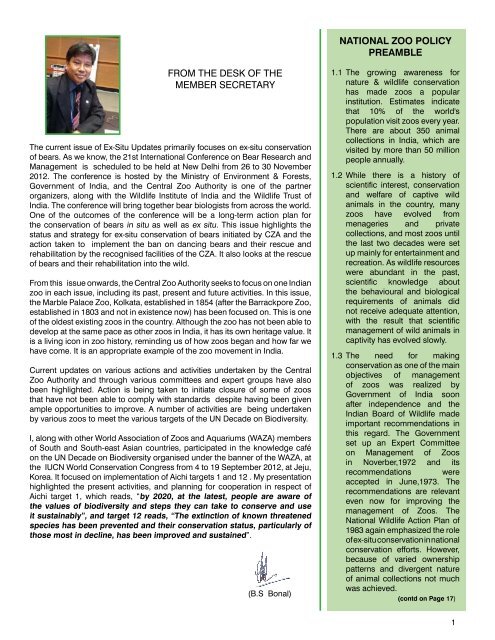Ex-Situ updates - Central Zoo Authority
Ex-Situ updates - Central Zoo Authority
Ex-Situ updates - Central Zoo Authority
Create successful ePaper yourself
Turn your PDF publications into a flip-book with our unique Google optimized e-Paper software.
FROM THE DESK OF THE<br />
MEMBER SECRETARY<br />
The current issue of <strong>Ex</strong>-<strong>Situ</strong> Updates primarily focuses on ex-situ conservation<br />
of bears. As we know, the 21st International Conference on Bear Research and<br />
Management is scheduled to be held at New Delhi from 26 to 30 November<br />
2012. The conference is hosted by the Ministry of Environment & Forests,<br />
Government of India, and the <strong>Central</strong> <strong>Zoo</strong> <strong>Authority</strong> is one of the partner<br />
organizers, along with the Wildlife Institute of India and the Wildlife Trust of<br />
India. The conference will bring together bear biologists from across the world.<br />
One of the outcomes of the conference will be a long-term action plan for<br />
the conservation of bears in situ as well as ex situ. This issue highlights the<br />
status and strategy for ex-situ conservation of bears initiated by CZA and the<br />
action taken to implement the ban on dancing bears and their rescue and<br />
rehabilitation by the recognised facilities of the CZA. It also looks at the rescue<br />
of bears and their rehabilitation into the wild.<br />
From this issue onwards, the <strong>Central</strong> <strong>Zoo</strong> <strong>Authority</strong> seeks to focus on one Indian<br />
zoo in each issue, including its past, present and future activities. In this issue,<br />
the Marble Palace <strong>Zoo</strong>, Kolkata, established in 1854 (after the Barrackpore <strong>Zoo</strong>,<br />
established in 1803 and not in existence now) has been focused on. This is one<br />
of the oldest existing zoos in the country. Although the zoo has not been able to<br />
develop at the same pace as other zoos in India, it has its own heritage value. It<br />
is a living icon in zoo history, reminding us of how zoos began and how far we<br />
have come. It is an appropriate example of the zoo movement in India.<br />
Current <strong>updates</strong> on various actions and activities undertaken by the <strong>Central</strong><br />
<strong>Zoo</strong> <strong>Authority</strong> and through various committees and expert groups have also<br />
been highlighted. Action is being taken to initiate closure of some of zoos<br />
that have not been able to comply with standards despite having been given<br />
ample opportunities to improve. A number of activities are being undertaken<br />
by various zoos to meet the various targets of the UN Decade on Biodiversity.<br />
I, along with other World Association of <strong>Zoo</strong>s and Aquariums (WAZA) members<br />
of South and South-east Asian countries, participated in the knowledge café<br />
on the UN Decade on Biodiversity organised under the banner of the WAZA, at<br />
the IUCN World Conservation Congress from 4 to 19 September 2012, at Jeju,<br />
Korea. It focused on implementation of Aichi targets 1 and 12 . My presentation<br />
highlighted the present activities, and planning for cooperation in respect of<br />
Aichi target 1, which reads, “by 2020, at the latest, people are aware of<br />
the values of biodiversity and steps they can take to conserve and use<br />
it sustainably”, and target 12 reads, “The extinction of known threatened<br />
species has been prevented and their conservation status, particularly of<br />
those most in decline, has been improved and sustained”.<br />
(B.S Bonal)<br />
NATIONAL ZOO POLICY<br />
PREAMBLE<br />
1.1 The growing awareness for<br />
nature & wildlife conservation<br />
has made zoos a popular<br />
institution. Estimates indicate<br />
that 10% of the world's<br />
population visit zoos every year.<br />
There are about 350 animal<br />
collections in India, which are<br />
visited by more than 50 million<br />
people annually.<br />
1.2 While there is a history of<br />
scientific interest, conservation<br />
and welfare of captive wild<br />
animals in the country, many<br />
zoos have evolved from<br />
menageries and private<br />
collections, and most zoos until<br />
the last two decades were set<br />
up mainly for entertainment and<br />
recreation. As wildlife resources<br />
were abundant in the past,<br />
scientific knowledge about<br />
the behavioural and biological<br />
requirements of animals did<br />
not receive adequate attention,<br />
with the result that scientific<br />
management of wild animals in<br />
captivity has evolved slowly.<br />
1.3 The need for making<br />
conservation as one of the main<br />
objectives of management<br />
of zoos was realized by<br />
Government of India soon<br />
after independence and the<br />
Indian Board of Wildlife made<br />
important recommendations in<br />
this regard. The Government<br />
set up an <strong>Ex</strong>pert Committee<br />
on Management of <strong>Zoo</strong>s<br />
in Noverber,1972 and its<br />
recommendations were<br />
accepted in June,1973. The<br />
recommendations are relevant<br />
even now for improving the<br />
management of <strong>Zoo</strong>s. The<br />
National Wildlife Action Plan of<br />
1983 again emphasized the role<br />
of ex-situ conservation in national<br />
conservation efforts. However,<br />
because of varied ownership<br />
patterns and divergent nature<br />
of animal collections not much<br />
was achieved.<br />
(contd on Page 17)<br />
1
















